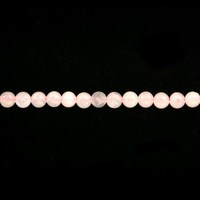Beader’s dictionary
C
CARNELIAN (See products)
Carnelian is a gemstone of the chalcedony family. It can be translucent to opaque and its color ranges from reddish brown to reddish orange. Its color is due to the presence of iron oxides and is similar to the pulp of the dogwood’s fruit (a reddish type of berry). It is often mistaken with the dyed agate. This gemstone is naturally prevalent in India, Brazil and Uruguay.
CHALCEDONY (See products)
The term chalcedony designates all varieties of quartz and microcrystalline and cryptocrystalline. It includes agate, carnelian, jasper, onyx and other varieties of quartz. However, the term chalcedony is often used to denote the common chalcedony sensu stricto. It can have a milky appearance and be transparent, and bluish white-grey.
It can be dyed as it is porous. It can be found in Brazil, the United States, India, Madagascar, Namibia, Sri Lanka and Zimbabwe.
A little bit of history: The name comes from the Greek "Karchêdôn", an ancient transit city on the Bosphorus (Istanbul strait). Roman and Egyptian used it in cameos, seals and amulets. Today, it is often found in the form of a cabochon, as beads, rings or artifacts. In the Neolithic period, chalcedony was used to make tools.
G
GURU BEAD (See products)
Guru beads are rounds beads that have three holes when they are looked at from the outside. If we could see through the bead, the bead’s hole would be shaped like a “T”. These beads are always paired with a second conically shaped bead. They are used to join string ends. Both string extremities are threaded in the holes above the “T” and are exited together in the hole bellow the “T”. Following which, the conic bead is strung and the strings are tied together. Their size vary, however they more often than not measure about 8mm. They are generally made with semiprecious stones such as agates, cornelian and onyx but can also be made of wood and glass. The guru beads are often used to finish bracelets or mala bead necklaces (Buddhist or Hindu rosaries). This part of the rosary would represent Buddha or the master, thus the name guru.
Q
QUARTZ
The term "quartz" refers to a family of minerals within the group of silicates. Quartz composes 12% of the lithosphere (outermost shell) and is the most common mineral. Quartzs are divided into different categories, among them the macrocrystalline quartz (amethyst, citrine, rock crystal, quartz smoke, rose quartz, blue quartz, quartz cat-eye, iron-eye, falcon-eye and tiger-eye ) and microcrystalline quartz (chalcedony, carnelian, onyx, agate, chrysoprase, jasper and petrified wood).
Z
ZODIAC STONES
During Antiquity as well as Middle-Ages, it was believed that the formation of gems was influenced by constellations, some gems were as bright as stars. They were thought to be the mirrors of the cosmos. Therefore each planet was associated with one or more gems that possess “magical” properties. These beliefs still circulate in todays modern society, even though there are no tangible proof to support them.
| Sign | Stones |
|---|---|
| ARIES | Carnelian, red jasper |
| TAURUS | Carnelian, pink quartz |
| GEMINI | Citrine, tiger's eye |
| CANCER | Chrysoprase, aventurine |
| LEO | Rock crystal, golden quartz |
| VIRGO | Citrine, yellow agate |
| LIBRA | Orange citrine, smoked quartz |
| SCORPIO | Blood red Carnelian |
| SAGITTARIUS | Sapphire, chalcedony |
| CAPRICORN | Onyx, rutilated quartz |
| AQUARIUS | Turquoise, falcon eye |
| PISCES | Amethyst, quartz amethyst |












